|
Click on a picture for a more detailed
image.
|
|
|
|
|
|
|
|
Seaside serenade: with this evocative photograph of a pillbox
below Burton Cliff having its story told in the contemporary caption
from April 1944.
"In 1940 the village beach was guarded against
invasion, first by Local Defence Volunteers, then by Home Guards.
Today, with the tables turned, U.S. troops can spend their leisure
hours on it. Sitting on a concrete blockhouse, behind which Britain's
amateur ill-armed soldiers were prepared to sell their lives dearly,
Corporal Bert Markowitz, 30-46, 23rd Street, Astoria, Borough of
Queen's N.Y.C., plays his violin. Markowitz, a student at the University
of Miami, played with the N.B.C. as studio musician. Listening to
him is T/5 G.R. Miller, 4106 Vermont Ave. Louisville, Kentucky."
|
|
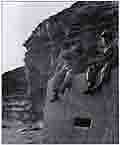 |
|
|
|
| Generation
gap: Bridged by cocoa, in N.A.A.F.I. cups, provided by Corporal
David W. Roberts, from Iowa, who leans out of his holiday camp billet
at Freshwater, Burton Bradstock. Betty "Freckles" Mackay,
a London evacuee from the blitz, is accompanied by local boy Chris
Kerley.
|
|
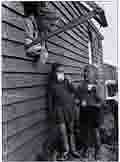 |
| |
|
|
| Liz
(as she is now known) Mackay as she is today - still living in the
village! |
|
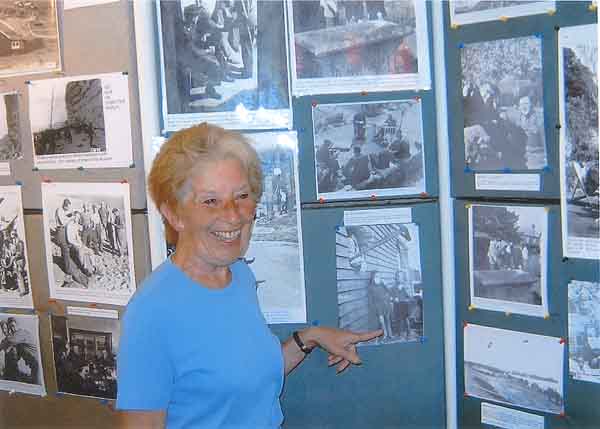 |
|
|
|
| Chesil
Beach: Eyes towards France in April 1944, from Burton Beach, as
American GIs prepare to take the war back across the channel.
|
|
 |
|
|
|
| Gun
Belt: Beach-found, according to the original caption, though that
sounds contrived. The soldiers around the iron seat that circles the
Sycamore tree on the triangle of the village green in Burton Bradstock
village, are John L. Lawson of Port Jervis, New York; Robert S. Hastings
of Azusa, California; Leo H. Pearson of Springville, New York; and
Corporal Roland Henry of Holland, Pennsylvania.
|
|
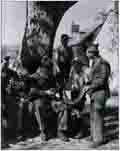 |
|
|
|
| Haircut
Time: Above the ears, in April 1944 at a late afternoon open-air
hair salon on a boulder in the shingle at Freshwater, Burton Bradstock.
The Americans occupied the nearby holiday camp. |
|
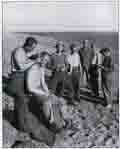 |
|
|
|
| Gas
Station: Village boy mans A.E. Cheney's pumps at Red House Garage,
Burton Bradstock, as another cleans the windscreen of an American
Jeep, in April 1944. Behind the thatched cottage is the village playing
field with the church tower in the distance. The presence of an "Headquarters"
vehicle shows the importance of this photographic session. |
|
 |
|
|
|
| Village
Canteen: Gunner Weightman of the British Army, an old habitue,
hands round home-made cakes in April 1944 at Burton Bradstock, to
Corporal James Flower of Walpole, Massachusetts, Private First-class
Roy St. Jean of Springfield, Mass., and Corporal Allan Decker of Chicago. |
|
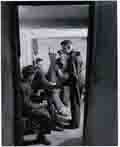 |
|
|
|
| Rectory
Tea: On the lawn behind St. Mary's Parish Church at Burton Bradstock,
in April 1944. The hosts are Rev and Mrs. Arthur Dittmer and their
white-pawed tabby cat. Their United States Army guests are Lieutenant
S.M. Weitzner of Ridgewood, New York, and Major E.M. Beebe of Burlington,
Vermont. The latter was the manager of the telephone company in Burlington.
The detail in these captions makes it clear that they were intended
for a trans-Atlantic audience.
|
|
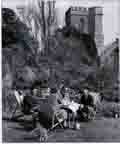 |
|
|
|
| Tasting
Tea: "Britain's traditional social meal" as the caption
had it in April 1944, being poured by the village schoolmaster's wife
at Burton Bradstock. Sergeant Harold D. Kregar, from Cheyenne Wells,
Colorado, won the Legion of Merit in Iceland.
|
|
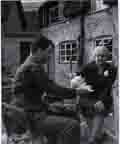 |
|
|
|
| Asking
Directions: "The way to the village canteen", according
to the original caption, with Private First-Class Roy St. Jean of
Springfield, Massachusetts, chatting to Petty Officer Podger "lately
invalided out of the Royal Navy" who was born in Burton Bradstock
and served in both world wars.
|
|
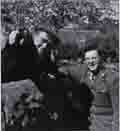 |
|
|
|
| Lucky
Horseshoe: Being presented by blacksmith Benjamin Burton to the
Commanding Officer of the American unit, by the smithy at Burton Bradstock.
The officer has a sticking-plaster over a recent wound to his forehead.
April 1944 was a time of much training and familiarisation with live
explosives.
|
|
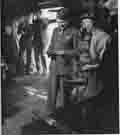 |
|
|
|
| Making
Friends: This was a general theme in this set of propaganda photographs,
with an American arm on the boy's shoulder and Burton Bradstock's
blacksmith Benjamin Burton showing the horses hoof. "US Troops
are discovering that the Britisher is not as stand-offish as he is
said to be", the contemporary caption reads.
|
|
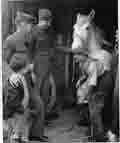 |
|
|
|
|
| Common
Culture: The propaganda behind this superb series of photographs
was every bit as good as the photograph - for here the subtle inference
is that with a date before 1783, Britain and the United States share
a common history. The Rector of Burton Bradstock, Rev Arthur Dittmer,
points out an inscription on one of his table-tombs, to Major E.M
Beebe of Burlington, Vermont and Lieutenant S.M. Weitzner of Ridgewood,
New York.
|
|
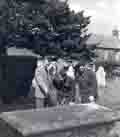 |
|
|
|
| Deliberate
Misinformation: The location of these photographs remained a national
secret until they were first seen by the present author. This scene,
in the Dove Inn at Southover, Burton Bradstock, has a prominent poster
for Brewers H. and G. Simonds Limited of Reading . There is also a
Simonds calendar, dating the series April 1944. Though the company
also has a depot in Blandford, the prominence of the poster and the
projecting nail holding it in place are unlikely to be coincidental;
every effort was being made to suggest that the invasion would come
from further east. As for the setting, the GI offensive began with
English public houses. Their pint was beer - darker but less potent
than the rough cider of the locals.
|
|
 |
|














